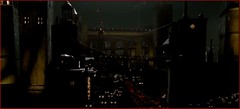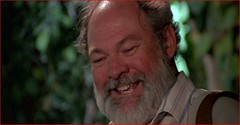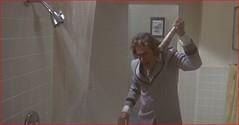Over the past year I've been slowly digesting producer Val Lewton's horror movies from the 1940s. I've found that they're a lot like good hamburgers, in that the last one you've had always seems like the best one you've ever eaten. I was ready to be disappointed with his other works after being blown away by the creative chills of The Leopard Man, but then I saw Cat People, and then The Body Snatcher was my favorite, which was then trumped by I Walked With a Zombie, before that was usurped by Ghost Ship. It would be impossible for me to rank Lewton's horror movies, as they are all so similar in quality, yet very different in subject matter.
The latest Lewton Burger to top my list is The Seventh Victim, which I watched twice this weekend (finally broke down and bought The Val Lewton Horror Collection -- now that it includes Scorsese's The Man in the Shadows documentary). Like all of Lewton's movies, The Seventh Victim has scenes and sequences that will stay with you long after its short 71 minute running time is up. Similar to its stablemates The Seventh Victim has a constant air of death -- this time dealing with a woman who has always been "obsessed with death" and never afraid of it. The woman is Jacqueline Gibson, a young owner of a beauty products business who has recently gone missing. Her only relative is sister Mary Gibson, who is informed of her sibling's disappearance by her school masters before setting out to New York City to find the truth. Mary and a private investigator think they have found her sister's location in a locked room, but the detective emerges from it not with Jacqueline, but with a fatal stab wound. After running for her life, Mary learns her sister may have unwisely come under the ire of a mysterious group of devil-worshippers called the Palladists.
A scene that jumped out immediately to me was Jacqueline's startling entrance -- where should this rank among the all-time great character entrances? If Harry Lime is No. 1, then Jacqueline's scene has to be in the top 5. Her name is mentioned multiple times in every scene, and the movie is about her disappearance -- yet we never see her until she's abruptly revealed behind a knock on a door. Jacqueline's silent introduction and subsequent vanishing make the scene all the more memorable.
Though we see little of New York City, director Mark Robson is able to add small background touches to make the locale grow more sinister as Mary and her allies plunge deeper into Jacqueline's disappearance. The most prevalent of these for me was this oddly prominent sign above the morgue, which is only seen for a few seconds...
Creepy!
More mystery than suspense, The Seventh Victim has a handful of scares, with the most noteworthy being a bathroom confrontation that set the table for Hitchcock's seminal scene:
Watching it a second time, I noticed details that didn't stand out during the initial viewing. What pleased me the most was seeing a Palladist symbol projected onto Mary while she and the detective break into the factory. It's easy to miss upon first viewing, because the symbol at this point in the movie has no meaning. Although one is partially obscured by the detective's shadow, when Mary passes in front of the light, there are four Palladist symbols in view:
What an amazing shot, especially since the corridor we're focused on also features the silhouette-filled window where any number of evils could be lurking. This is probably the best-directed scene in the film, especially from a horror sense. The tension builds at a believable pace, even though there's really nothing happening beyond waiting for a character to open a door. The door itself is even scary, it's draped in just the right amount of darkness, and shot in such a way (with near silence) that your imagination instantly fills in the amount of terror that could lurk behind it.
I also noticed that the preface sonnet is actually taken from the stained-glass window at Mary's school. Seems pretty morbid for a stained-glass window at a girls' school:
The aforementioned scenes and elements are so great that they largely mask the storytelling deficiencies of The Seventh Victim. Though it's only 71 minutes, this is a thick plot that never feels like it properly unfolds. The short running-time has been attributed to RKO Studios punishing Lewton for his choice of rookie Robson as a director -- they reportedly demanded Lewton to find someone else or have his project slapped as a B-movie. Lewton obviously chose the latter, and had to excise four crucial scenes (disappointingly missing from the DVD). Those with knowledge of these scenes say they did not completely remedy the film's confusing plot, but greatly aided certain aspects such as the unexplained matter of how the Palladists located Jacqueline while she was in hiding, and how Dr. Judd was able to know so much about the group. But even with these four scenes restored, it seems we would still not see any more of Jacqueline -- too bad because it seems like her strange, death-obsessed character deserves more screen time and depth.
As it is, The Seventh Victim is a challenge to keep up with. There are probably too many characters, and by the end I felt like I didn't know much about any of them (I'm still confused by Jason). But any frustration was quickly erased by the movie's many moments of brilliance, in particular the last act. The movie is at its best when the Palladists are on screen, and I think it's best that we never learn too much about them. Judd and Ward's moral confrontation with the lead Palladist is a triumph, and it could have been even better if the latter's last line was more sharply written (or possibly delivered by a superior actor). The morbid ending may be my favorite of any Lewton film, and it's amazing that it survived the Production Code cutting room. The Seventh Victim currently stands as my favorite Val Lewton flick, but of course that's subject to change when I get around to seeing Isle of the Dead, Bedlam or Curse of the Cat People.
Monday, March 24, 2008
'And all my pleasures are like yesterday'
Filed Under Classic reviews
Subscribe to:
Post Comments (Atom)

















3 comments:
Great post Adam...
I found I got a lot more out of "The Seventh Victim" the second time I saw it, though I had never noticed those symbols.
I think you'll really like both "Bedlam" and "Isle Of The Dead". Some people think they are second tier Lewton, but I think they are at least equal to the more famous Tourneur films. "Isle Of The Dead" has one of my favourite sequences in all of Lewton's films - a wordless period during which our heroine walks alone on the island.
I have to watch both "Curse Of The Cat People" and "The Leopard Man" again as I saw them early on and haven't watched them since.
Thanks, Bob. I'm looking forward to the last few Lewtons I haven't seen, even though I've heard mixed opinions about them. It's great that all his films are available in such an affordable package.
Really useful information, lots of thanks for your post.
here
Post a Comment